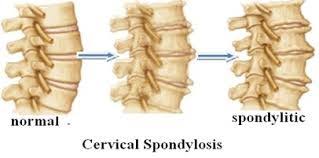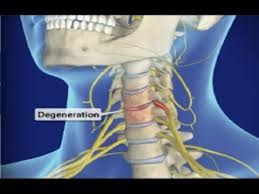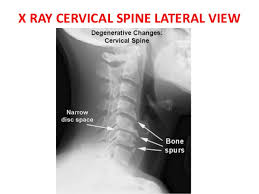Cervical spondylosis also called as arthritis of the neck, is related to age-related, wear and tear changes that occur over time. Mostly it occurs over the age of 60 years and above.
Following Are The Causes Of Cervical Spondylosis:
- Bone Spurs:These are the overgrowths of bone which can press the delicate areas of spine-like spinal cord and spinal nerves. It results due to wear and tear of the cartilage of the bone.
- Dehydrated And Herniated Spinal Disc:The disc present in between the vertebrae act as a shock absorber in case of lifting, twisting etc. The gel material inside the disc can dry out causing bones to rub over each other causing pain. Sometimes the disc develops cracks and leaks out impinging the spinal nerves thus resulting in numbness and pain down in arm.
- Injury:
Injury to the neck after a fall or car accident can also lead to cervical spondylosis.
- Faulty Posture:
It results due to certain occupations like long-sitting jobs as in computer works, teaching or lifting of heavyweights as in construction works or gymming. These kinds of postures put extra pressure over spine causing early wear and tear of cartilage and ligaments.
- Pain and stiffness in the neck and sometimes in the shoulder
- Headaches
- Numbness and tingling sensation in the hands, fingers, and arm
- Muscle spasm in neck and shoulder
- Vertigo
How Will You Diagnose This?
- X-ray: Shows bone spurs and alignment of bones in the neck.
- CT SCAN: Provide more detailed images of your neck.
- MRI: Gives better images of soft tissues like disks, nerves and spinal cord. It helps to locate bulging or herniated disks.
- MYELOGRAM: Dye is injected to highlight certain areas of the spine. CT SCAN or X-RAYS are then taken to see the detailed images.
- ELECTROMYOGRAPHY(EMG): It measures the electrical impulses of muscle at rest and during contraction. Nerve conduction is often done along with it to see if the spinal nerve is functioning properly.
- PHYSICAL EXAMINATION DONE BY DOCTOR: He/ she checks for the strength of arms, hands, and fingers along with a range of motion of cervical spine and arms. Also, trigger points, muscle spasm is being checked around the neck area.
Treatment Of Cervical Spondylosis:
- PHYSIOTHERAPY:
It includes the use of therapeutic modalities like hot packs, TENS, IFT, cervical traction, ultrasonic etc in relieving pain and other related cervical spondylosis symptoms. Specific strengthening and stretching exercises of neck muscles also help in alleviating the pain and stiffness..sessions vary from patients to patients and generally lasts for about 6-8 weeks.
- MEDICATIONS:
During the initial phase, several medications are prescribed to reduce both pain and inflammation like acetaminophen, NSAIDs and muscle relaxants like cyclobenzaprine.
- CERVICAL COLLAR:
It is worn to limit neck range of motion and helps in case of vertigo.
- SURGERY:
Recommended only when the symptoms are not getting relieved by above methods i.e in cases of the pinched nerve or spinal cord compression.
Source: Wikipedia
- Dehydrated And Herniated Spinal Disc:The disc present in between the vertebrae act as a shock absorber in case of lifting, twisting etc. The gel material inside the disc can dry out causing bones to rub over each other causing pain. Sometimes the disc develops cracks and leaks out impinging the spinal nerves thus resulting in numbness and pain down in arm.
- Injury:
Injury to the neck after a fall or car accident can also lead to cervical spondylosis.
- Faulty Posture:
It results due to certain occupations like long-sitting jobs as in computer works, teaching or lifting of heavyweights as in construction works or gymming. These kinds of postures put extra pressure over spine causing early wear and tear of cartilage and ligaments.
- Pain and stiffness in the neck and sometimes in the shoulder
- Headaches
- Numbness and tingling sensation in the hands, fingers, and arm
- Muscle spasm in neck and shoulder
- Vertigo
- Injury:
Injury to the neck after a fall or car accident can also lead to cervical spondylosis.
- Faulty Posture:
It results due to certain occupations like long-sitting jobs as in computer works, teaching or lifting of heavyweights as in construction works or gymming. These kinds of postures put extra pressure over spine causing early wear and tear of cartilage and ligaments.
- Pain and stiffness in the neck and sometimes in the shoulder
- Headaches
- Numbness and tingling sensation in the hands, fingers, and arm
- Muscle spasm in neck and shoulder
- Vertigo
How Will You Diagnose This?
- X-ray: Shows bone spurs and alignment of bones in the neck.
- CT SCAN: Provide more detailed images of your neck.
- MRI: Gives better images of soft tissues like disks, nerves and spinal cord. It helps to locate bulging or herniated disks.
- MYELOGRAM: Dye is injected to highlight certain areas of the spine. CT SCAN or X-RAYS are then taken to see the detailed images.
- ELECTROMYOGRAPHY(EMG): It measures the electrical impulses of muscle at rest and during contraction. Nerve conduction is often done along with it to see if the spinal nerve is functioning properly.
- PHYSICAL EXAMINATION DONE BY DOCTOR: He/ she checks for the strength of arms, hands, and fingers along with a range of motion of cervical spine and arms. Also, trigger points, muscle spasm is being checked around the neck area.
Treatment Of Cervical Spondylosis:
- PHYSIOTHERAPY:
It includes the use of therapeutic modalities like hot packs, TENS, IFT, cervical traction, ultrasonic etc in relieving pain and other related cervical spondylosis symptoms. Specific strengthening and stretching exercises of neck muscles also help in alleviating the pain and stiffness..sessions vary from patients to patients and generally lasts for about 6-8 weeks. - MEDICATIONS:
During the initial phase, several medications are prescribed to reduce both pain and inflammation like acetaminophen, NSAIDs and muscle relaxants like cyclobenzaprine. - CERVICAL COLLAR:
It is worn to limit neck range of motion and helps in case of vertigo. - SURGERY:
Recommended only when the symptoms are not getting relieved by above methods i.e in cases of the pinched nerve or spinal cord compression.














0 comments:
Post a Comment